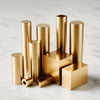
How is Aluminum CNC Machining Applied in the Consumer Electronics Industry?
Discover how aluminum CNC machining enables high-precision, lightweight components for consumer electronics. Learn applications in smartphone frames, heat sinks, and internal structures with superior finish quality.

What are the Processes in Aluminum Prototypes?
Explore key aluminum prototyping: CNC machining, 3D printing & investment casting. Compare precision, cost & speed for functional prototypes. Ideal for automotive, aerospace & industrial applications.

Rapid Prototyping-CNC Aluminum Machining
Fast & Precision Rapid Prototyping with CNC Aluminum Machining – High-Quality Functional Prototypes in Days. Ideal for Automotive, Aerospace & Industrial Applications. Get Instant Quote!

Exposing Hidden Waste in CNC Machining: Reduce Your Part Processing Time by 90%!
As a procurement manager for components, do you often face significant discrepancies in CNC machining quotes? Behind the price differences lies a major culprit—processing waste. This includes material loss, tool scrapping, rework, downtime, and more. Ultimately, all waste is reflected in your quoted price.
Competing by squeezing profit margins is unsustainable. The real solution is waste reduction! In this blog, we openly share our factory’s core strategies and real data for minimizing CNC waste—revealing why we offer greater value.

Aluminum 6061 vs 7075: The Definitive Guide to Choosing Your Alloy
Introduction: The Critical Crossroads
In precision engineering, selecting the right aluminum alloy can mean the difference between optimal performance and catastrophic failure. 6061 and 7075 – two of the most widely used alloys – sit at opposite ends of the aluminum spectrum. While 6061 offers versatility and economy, 7075 delivers aerospace-grade strength. Yet misapplying either can lead to costly redesigns, premature failures, or bloated budgets.





